Overview
Imperilled Democracy
The world over, the year 2023-2024 witnessed democracy in action, with the ballot of more than two billion people in about 50 countries making momentous choices. The world’s most populous region – South Asia – saw citizens in Bangladesh, Bhutan, the Maldives, Pakistan, India and Sri Lanka either vote, or gear up to elect governments.
Bhutan, though a newcomer to democracy, nevertheless had a peaceful transfer of power, with Prime Minister Tshering Tobgay highlighting the watchdog role of the media in pressing for accountability and adherence to democratic principles.
In the rest of the South Asian neighbourhood, however, democracy seemed precarious, with physical violence and bomb blasts marking polling in both Bangladesh and Pakistan and misinformation, deep political, religious and ethnic divides accompanied by sharply polarised media coverage of the election campaigns in India and Sri Lanka. In the Maldives, though the closely contested presidential elections in 2023 saw both the government-owned and private media being partisan and favouring the government, the defeat of the incumbent President Solih showed that the polling process was relatively fair.
With elected autocracies gaining ground globally, the synergy between freedom of expression and robust democracy was never more apparent in the year in review. Controlling the airwaves, curbing access to information, taming and pressurising the media and crushing dissent was the modus operandi of the autocrats and their corporate cronies.
In South Asia, home to one in five of the world’s people and with common histories of colonialism, heterogenous communities and deep inequalities, the media endeavoured to speak truth to power, particularly at critical election junctures. Yet, the year under review saw the erosion of the expected institutional safeguards for an independent media, due to which the Sustainable Development Goal (SDG) of ensuring public access to information and protecting fundamental freedoms remained disappointingly unfulfilled in the region.
The future of media in this context remains more critical than ever. With legacy media across the region still alarmingly over-dependent on government or corporate revenue, independent voices continue to move over to digital platforms to challenge the establishment through professional journalism. In a digital eco-system bursting with YouTubers and content producers on Tik Tok, carving out a space amidst paid influencers and channels that fall as rapidly as they rise, has not been easy. Despite financial difficulties, stringent government surveillance and harassment, some tenacious journalists strive to keep professionalism alive, either solo or in small media ventures. The courage of these small organisations has attracted the wrath of the government, leading to renewed attempts to strengthen regulation and control over the media.
With elected autocracies gaining ground globally, the synergy between freedom of expression and robust democracy was never more apparent in the year in review.
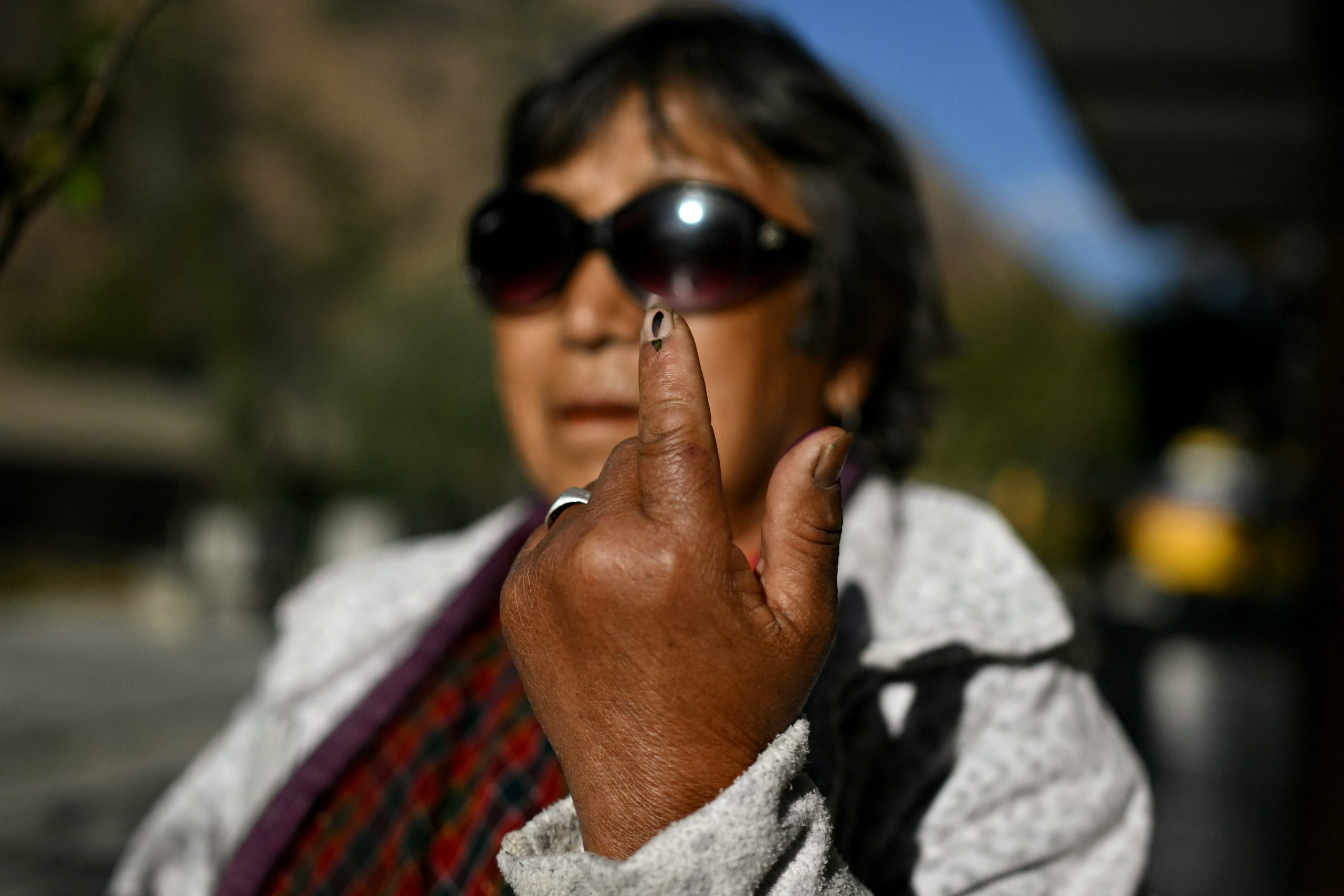
A voter shows an ink mark on their finger after casting a ballot during general elections in Thimphu on January 9, 2024. Despite only adopting a democratic constitution in 2008, Bhutan’s National Assembly elections saw a peaceful transfer of power, with the media serving as an important watchdog through the process. Credit: Money Sharma / AFP
Inexorable slide
Ongoing crises in the region – both economic and political – continued to have a devastating impact on the media’s influence and sustainability in the past year.
In Sri Lanka, the impact of the ‘Aragalaya’ or grassroots movement was still causing waves. The ongoing financial crisis continued and inflation was at an all-time high, forefronting the nation’s struggle to survive. This pressure vacuum pushed concerns of civil liberties and press freedom off the radar even as journalists and activists associated with the Aragalaya continued to be harassed.
The backslide that began in Afghanistan after the Taliban’s takeover in 2021 continued to drive the country’s stability downward. Most of the hard-won freedoms for the media, for women, and human rights have been relegated to history, stalled or slid perilously behind amid a crisis of survival for what remains of the country’s media following a mass exodus of media workers from the country in recent years.
When the first elected government in Bhutan came to power in 2008, it inherited a severe economic crisis which was reflected in the state of the media, with newspapers closing and journalists quitting the profession in droves. The latest data from the Bhutan Media Foundation (BMF) in 2023 showed continuing falling newspaper circulation over the decade, even though newspapers continue to employ the highest number of journalists (41 per cent). Meanwhile, hundreds of journalists left the profession and the country out of frustration at low wages and poor working conditions.
In Nepal, the country’s Prime Minister Pushpa Kamal Dahal formed his third coalition government in a year in March 2024, after months of confabulations. Media workers already reeling under a spate of dismissals and wage struggles, were also subjected to attacks, both on and offline. Press freedom remained severely challenged.
The fourth presidential multi-party election in the Maldives in 2023, witnessed a peaceful hand over of power, after a hotly-contested run-off that was viewed as a test of the Indian Ocean archipelago’s nascent democracy, as well as its ties with China and traditional benefactor India. The country’s young media industry continued to evolve and push back on key industry counterpoints, giving testament to the right to freedom of expression enshrined in the constitution just a decade and a half ago. However, trust in the media was low, with the public holding the media responsible for fuelling political divides and dissensions.
Pakistan went through a chaotic year. The period saw a turnstile of three governments, including a six-month long constitutional limbo between an outgoing parliament and an incoming one, and an election marred by violence. Amid the volatility of the political mire, media freedoms continued to be tested on numerous fronts. Unrest continued to simmer in the tribal districts which remained marginalised and under the influence of tribal jirgas, or traditional ‘courts’. Likewise, civil unrest in Southern Balochistan amidst precarious digital connectivity added to the feeling of alienation from the country’s mainstream.
In India, a deeply polarised legacy media pushed the discourse onto digital media and social media, with YouTube becoming a major source of news. Independent journalism suffered in the mix of the online mire. Unfiltered, with no editorial oversight, social media has emerged as a contentious, often toxic space that mirrors and exacerbates existing social cleavages of gender, religion, caste and ethnicity. The government of Narendra Modi continued to issue thinly veiled threats, in the guise of “advisories” warning the media from publishing/telecasting false content that could potentially disturb communal harmony or public order.
In Bangladesh, Sheikh Hasina tightened her grip on the reins of power for a fifth term, in a sham election boycotted by the opposition. She seems comfortably positioned to consolidate her power unchallenged, without any checks and balances. Democratic rights, civil liberties and press freedom now look poised to slide further down the scale.
This pressure vacuum pushed concerns of civil liberties and press freedom off the radar even as journalists and activists associated with the Aragalaya continued to be harassed.
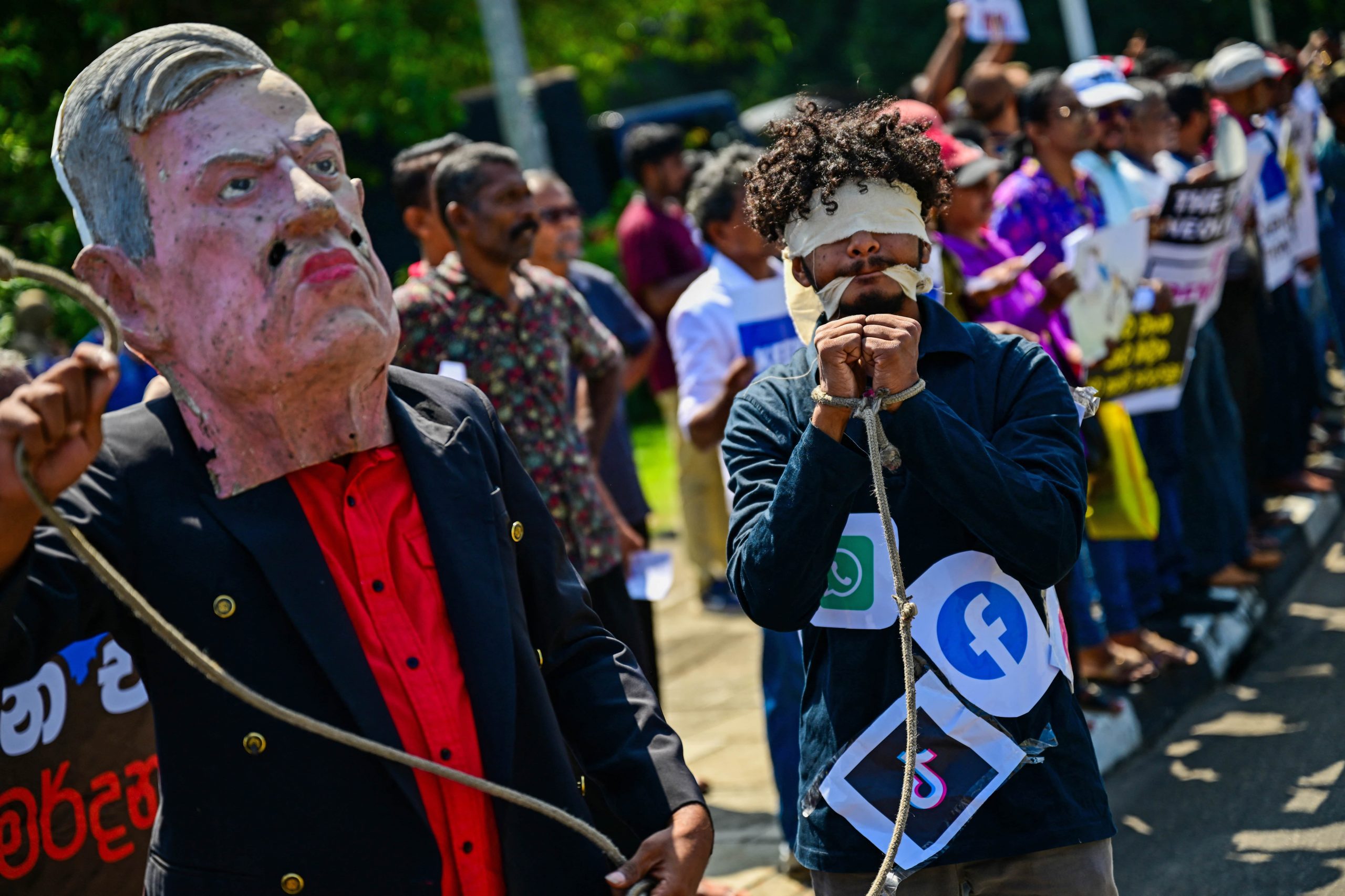
A blindfolded activist with rope around his wrists and covered with the logos of different social media platforms is dragged by a separate activist wearing a mask of President Ranil Wickremesinghe while protesting the Online Safety Act in Colombo on January 24, 2024. The law has been criticised for its potential to restrict expression online, with some identifying its targeting of protests in the vein of the 2022 Aragalaya. Credit: Ishara S. Kodikara / AFP
Attacking the messenger
Journalists across the region were subjected to physical assaults, abduction, arbitrary detentions, and some even paid the ultimate price for their work with eight journalists killed.
In Bangladesh, ten journalists died an “unnatural death”, with two being registered as murders, with three suspected murders being listed as road accidents.
Pakistan witnessed the killing of four journalists – two in Punjab and two in Sindh, which was dubbed one of the most dangerous places to practice journalism in the country.
In India, journalists came under attack from police, vigilantes and armed gangs who objected to their stories. One journalist was killed while on duty. Journalists attempting to report on the violent ethnic conflict that broke out in May 2023 in the northeastern state of Manipur found themselves under attack – from security forces as well as armed groups from both sides.
In Nepal, the Federation of Nepali Journalists and Nepal Press Union recorded 45 violations of press freedom from May 1, 2023 to April 30, 2024. Besides physical attacks, discrediting the media and journalists critical of politicians was also rife. Journalists investigating corruption, financial irregularities and administrative malfeasance were targeted, as in the past.
In the Maldives, the trend of impunity continued, with justice not being served for crimes against journalists. On November 22, 2023, the criminal court dropped terrorism charges against three suspects accused of plotting the murders of journalist Ahmed Rilwan and blogger Yameen Rasheed. The three men had been arrested in June 2022 after a breakthrough by the presidential commission on deaths and disappearances. The abrupt dismissal of charges over an alleged lack of evidence raised serious questions about the work of investigating authorities over the preceding years.
Slanderous attacks on journalists, which often lends impunity to physical attacks, were a feature in press conferences in the Maldives. The Maldives Journalists’ Association condemned “attempts to discredit journalists with unfounded and false allegations.”
Information blockade
Following the backslide in hard won rights in Afghanistan, the country’s Access to Information Law in 2014 (amended in 2018) has become all but defunct. Access has been curbed, with the government censoring the flow of information. Inevitably, it has led to a lack of transparency and accountability, as well as impeded the public’s right to information. Reporting on sensitive issues in the absence of authentic official data has lacked credibility, and women journalists face greater barriers in accessing information, since they are not granted interviews by authorities, nor are they usually invited to press conferences and other media events.
In Bhutan, which lacks a law to guarantee access to information, the appointment of government-affiliated officials to regulatory bodies like the Bhutan Infocomm and Media Authority (BICMA) is a matter of concern. Bureaucratic stonewalling and lack of transparency adversely impact the public’s right to vital information, according to journalists in Bhutan.
Access to information was marred by erasure of newspaper archives in Jammu and Kashmir and the Maldives. Since 2021, journalists in Kashmir began to notice that articles critical of the government at the centre had vanished from the online archives of prominent publications. The digital archives prior to 2019, the year in which the centre revoked Article 370 which granted special status to Jammu and Kashmir, have been partially or completely deleted in what has been described as the “enforced disappearance” of the media archive on the region. While “technical glitches” are the official explanation, the attempt to erase the history of dissent is apparent, and the loss of access to this historical record is immeasurable.
Over in the Maldives, a similar process unfolded with Haveeru, the country’s oldest newspaper, which was forced to shut down in 2016. On March 3, 2024, while an ownership battle was settled by the Supreme Court, the Maldives Journalists Association (MJA) noted the loss of the newspaper’s archive that represented “a record of many decades of Maldives’ history” as a major blow for the industry and the public’s right to know.
Recent developments in Maldives show that good laws alone are not sufficient. The Right to Information (RTI) Act of 2014 was ranked the 22nd strongest RTI law in the world out of 138 countries. But, as per a study by Transparency Maldives and the Information Commissioner’s Office of Maldives (ICOM) in 2023, though the media and members of the public were using the law, not a single state institution was fully compliant in following the law’s dictate and nearly half of state institutions covered by the law did not have a functional website; less than 20 per cent of required information was easily accessible.
Internet shutdowns continued to be used as a strategy to curb access to information and the right freedom of expression. In Manipur in northeast India, which was reeling under a violent ethnic conflict from May 2023, the internet was shut down for seven months and continues to be patchy in designated areas. Purportedly a measure to curb disinformation and the circulation of inflammatory videos and messages on social media, particularly WhatsApp, it has also effectively prevented journalists from verifying information and publishing credible news.
In Pakistan too, widespread internet shutdowns and curbs on social media access impacted freedom of expression and access to information during crucial events. On February 8, 2024, a nationwide suspension of mobile internet services on election day impeded the right to free speech. In May 2023, a four-day internet blackout was imposed during violent protests following the arrest of Imran Khan.
In Manipur in northeast India, which was reeling under a violent ethnic conflict from May 2023, the internet was shut down for seven months and continues to be patchy in designated areas.
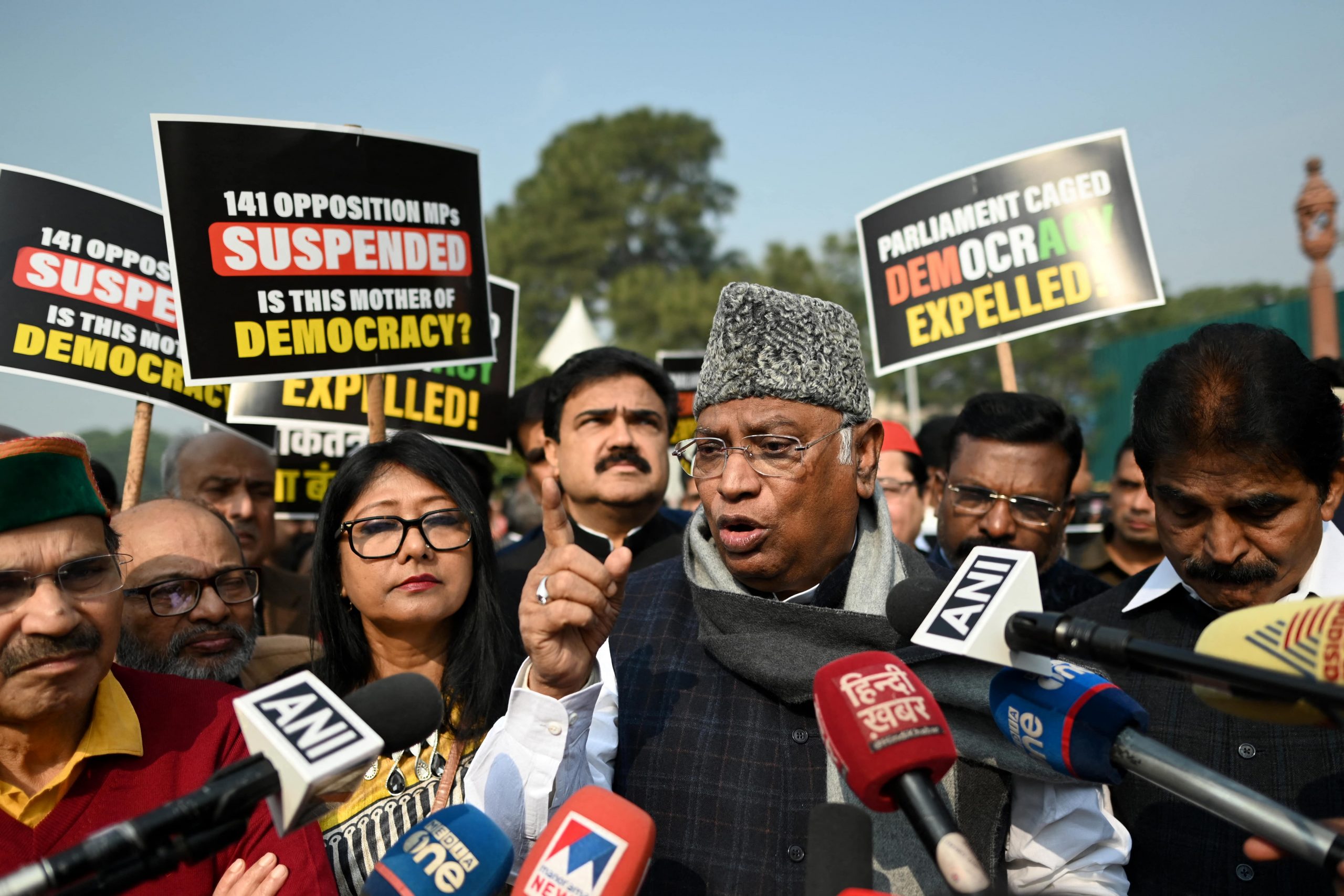
Indian National Congress party president Mallikarjun Kharge (C), along with other members of parliament, addresses the media after taking part in a protest against the suspension of 141 opposition MPs across 26 parties in New Delhi on December 21, 2023. Attacks, harassment, and insecurity have degraded the Indian media’s capacity to challenge threats to democracy. Credit: Sajjad Hussain / AFP
Dire financial straits
Climbing out of the economic pits following the Covid-19 pandemic, the media industry across the region is facing immense challenges.
In Afghanistan, media organisations are unable to hire new staff or pay decent wages to existing staff. The Taliban’s control over the media and the accompanying prohibitions on various forms of entertainment has devastated advertising revenue. Unable to produce programs that resonate with their audience and attract commercial partnerships, most media organisations remain cash-strapped. According to the Afghan Independent Journalists’ Union (AIJU), prior to 2021, there were 11,900 active media workers in the country, 2,833 of whom were women. However, after the Taliban takeover, only just over 4,700 journalists and media staff are currently active, just 700 of them women.
The media in Bhutan has survived on the back of government subsidies to newspapers houses. The subsidy being equally divided among all the private media houses regardless of their market share has prevented commensurate gains for the more efficient ones. The attrition rate among professional journalists continues to be high.
The decrease in the real GDP growth in Nepal, the lowest since 2020 literally drove Nepalis away from the country in search of better prospects. Nearly a million Nepalis, including students, left the country in the past year. For those that remain, the going is tough. Lack of payment and underpayment has plagued journalists from even prominent media houses. More than a hundred media outlets across the seven provinces of Nepal downed their shutters in 2023, and approximately 243 media personnel quit their jobs, as per data from the Freedom Forum. However, the numbers might be higher, in view of a lack of centralised database on job losses.
In India, many of the media staff who were laid off during and after the Covid-19 pandemic were forced to freelance or take up lesser paying and non-journalistic work. A critical issue is the lack of accurate data on the extent of the crisis, even as media houses continued to retrench their staff. In December 2023, a major media house with cross media ownership laid off 120 employees from its digital division. It was only through word of mouth that staff learned that their name was on ‘the list’. Not surprisingly, a survey by Delhi-based Centre for the Study of Developing Societies found that two third of the journalists surveyed were affected by the lack of security in their job. Toxic newsrooms and lack of job security came into focus with the sudden death of well-known journalists while on the job.
In the Maldives, the media’s dependence on state-owned enterprises (SOEs) for advertising revenue, self-censorship and undue influence is a key concern. Lack of regulation, transparency in allocation of advertising revenue has hampered accountability and continues to encourage political influence. Viability of the media independent of advertisement revenue has yet to be established.
In Pakistan, journalists laboured under a cloud of uncertainty and unpredictable layoffs. An IFJ survey led by the Pakistan Federal Union of Journalists (PFUJ) in 2023 in Sindh, found that only 39 per cent media staff were permanently employed and just 28 per cent had fixed term contracts. Lack of career opportunities, secure employment, uncertain and low wages and lack of benefits was the norm. This situation is common across the country.
Still steeped in a financial crisis, journalists in Sri Lanka faced further precarity. The Sri Lanka Broadcasting Corporation (SLBC) shut down its regional services and introduced a voluntary retirement scheme for the employees. Meanwhile, 149 journalists and media workers were laid off by the Associated Newspapers Ceylon Limited (ANCL). Many private media houses were barely able to pay wages, and introduced austerity measures, even cutting off legitimate allowances.
Drawing heavy criticism from home and abroad, the government replaced the Digital Security Act (DSA) with another law, the Cyber Security Act (CSA).
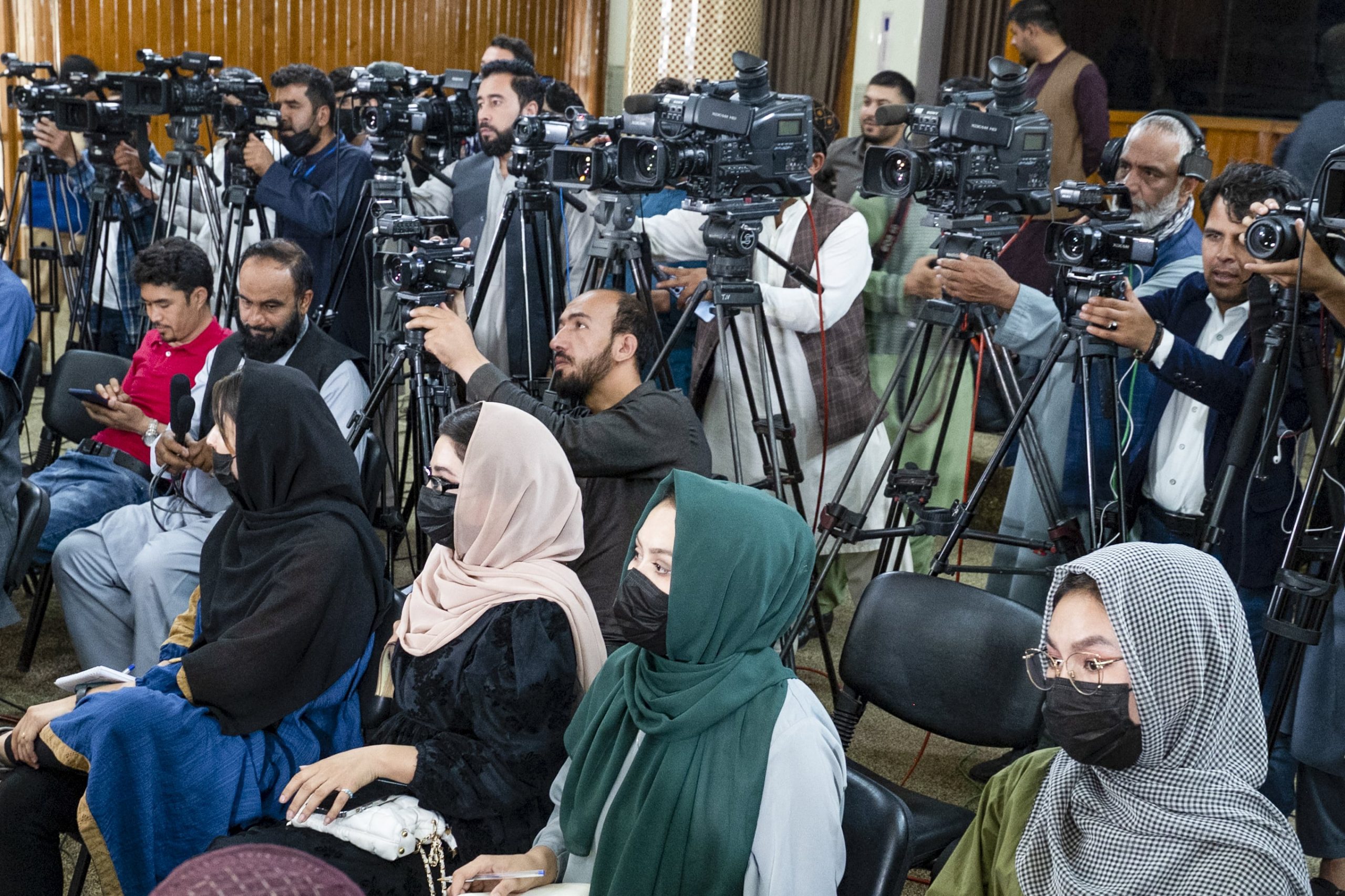
Afghan journalists attend a Taliban Ministry of Higher Education press conference in Kabul on August 21, 2023. Since August 2021, the Taliban has established strict barriers for journalists and media workers, with information funnelled through official channels, news restricted to official announcements, women barred from most press conference and media events. Credit: Wakil Kohsar / AFP
Long road to gender equity
Across the region, women journalists were worse off, whether due to conflict, or economic crisis. Hard won rights, whether to pursue a profession, move freely and be treated on par with their male colleagues remain a seemingly unattainable pipe dream for many.
Women journalists in Afghanistan under the Taliban continue to face restrictions including the requirement to cover their faces when appearing on television, the denial of participation in many press conferences and programs, and the ban on broadcasting women’s voices on radios in several southern provinces. Their freedom is curbed by the requirement to have a male guardian.
In fact, women journalists have all but disappeared from the south and southeast of Afghanistan, in Kandahar, Helmand, Zabul, Uruzgan, Paktia, Paktika, Khost and Logar.
Women in newsrooms in Nepal too continued to face challenges. A conference on embracing diversity, equity, and inclusion (DEI) organised by Nepal Investigative Multimedia Journalism Network (NIMJN) in November 2023, highlighted the lack of interest in DEI among senior level media decision-makers. From a lack of basic facilities lie washrooms and arrangements for sanitary hygiene, women journalists still face discrimination in assigning beats based on gender, caste and ethnicity. The gender pay gap is still an unfortunate reality.
Gender-based layoffs were seen in Sri Lanka, where the pandemic and the financial crisis severely impacted women’s employment in the media sector. Media organisations tended to lay off women while retaining men, thus further skewing the balance of female employment in the media.
The prevailing culture of impunity in the Maldives is also reflected in abuse faced by women journalists. Perpetrators in two prominent cases of sexual harassment in 2020, have not faced any charges. More than a quarter of women journalists, a third of the staff in mainstream media outlets have experienced sexual harassment, according to a report on gender equality in the media published by the MJA. Online abuse is rampant, with prominent women journalists being threatened with sexual assault and murder by anonymous social media users. Others have been intimidated by trolls demanding they censor their views online.
Pakistan’s women journalists faced similar harassment both online and offline. They are in a minority, and their voices unheard. A mapping published in December 2023 by the Women’s Media Forum Pakistan (WFMP), supported by the International Federation of Journalists (IFJ) and the National Press Club (NPC) found that despite women comprising around 5-30 per cent of media workforces in mapped areas, their representation in decision-making roles is less than 10 per cent or none at all. They are also grossly under-represented in unions and press clubs, the mapping found.
Women journalists in Afghanistan under the Taliban face continue to restrictions including the requirement to cover their faces when appearing on television, the denial of participation in press conferences and programs.
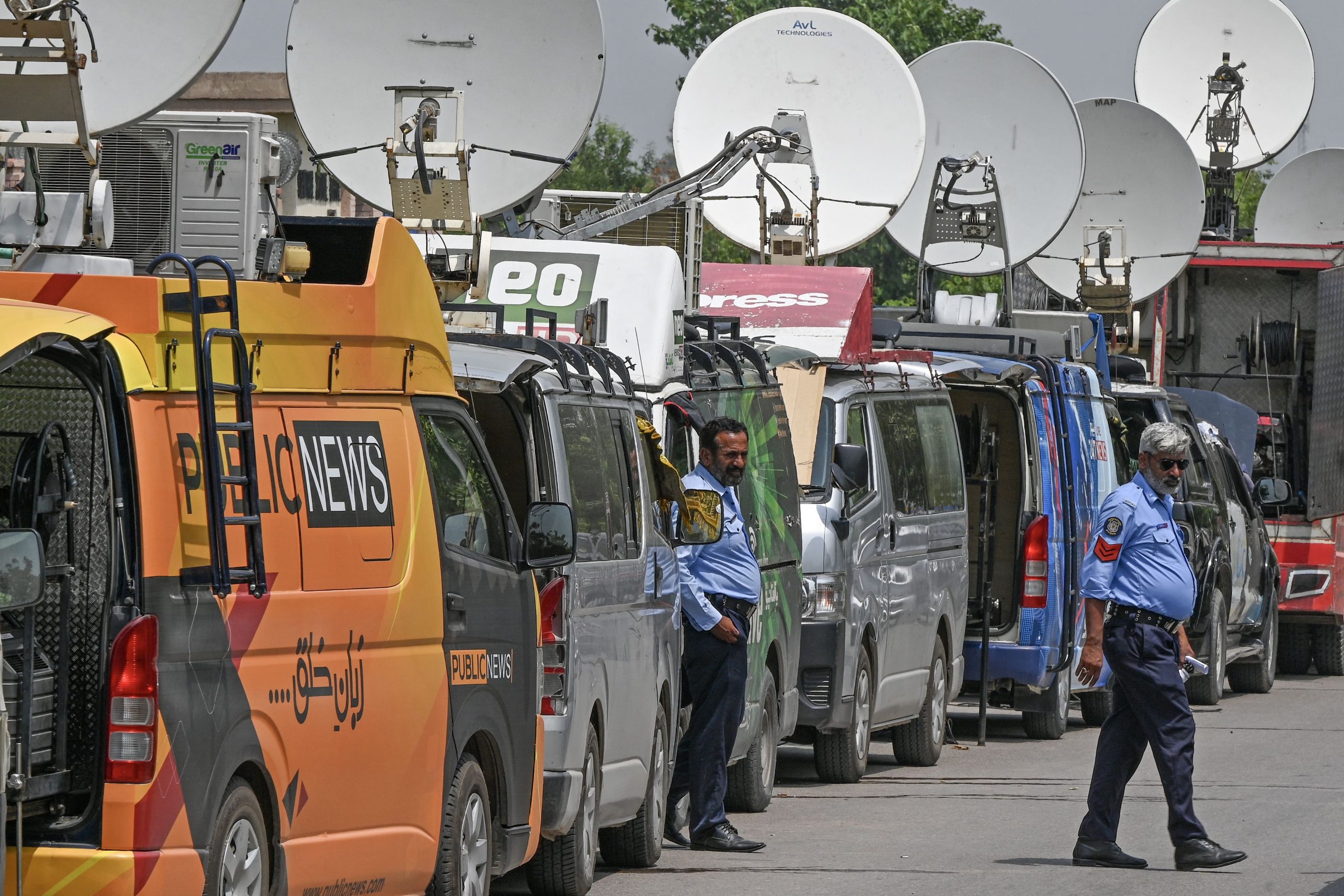
Police officers stand guard in front of news vans parked outside a special court hearing of jailed former Pakistani Foreign Minister and Pakistan Tehreek-e-Insaf (PTI) Vice Chairman Shah Mahmood Qureshi in Islamabad on August 21, 2023. Government instability and restrictions on PTI were a leading cause of unrest across Pakistan, with nation-wide, violent protests seen in the wake of former Prime Minister Imran Khan’s arrest in May. Credit: Farooq Naeem / AFP
Controlling the digital space
The landscape of online media in Afghanistan is complex and fraught with challenges. While some digital platforms continued to function with the support of the Taliban, those critical of the regime faced censorship and license revocation. Prominent online news websites like Roznama-e-Hasht Sobh and Ettela’at-e-Rooz had their licenses revoked. On the other hand, several YouTube channels which operate within the framework of the Islamic government, enjoy relatively more freedom.
In Nepal, Section 47 of the Electronic Transactions Act, 2008 is now a tool to arrest and threaten digital journalists. Even social media platforms operating in Nepal are under the scanner and were required to set up their offices in the country, for greater government oversight. The government released a 15-point social media directive on the Operation of Social Networking 2023 in November 2023, based on the Electronics Transaction Act (ETA). This directive has been viewed as problematic because of its potential for misuse against journalists.
Towards the end of 2023, during protests led by businessman Durga Parsai demanding the restoration of monarchy, the Nepali government banned TikTok, on grounds of it affecting social harmony. Other legislative measures such as the Media Council Bill, National Mass Communications Bill, Information Technology Bill, and Social Media Regulation and Management Bill and the Public Service Broadcasting Bill brought to unify state-owned media Radio Nepal and Nepal Television and transform into a public service broadcaster all continue to be under discussion.
Digital news media in India faced immense challenges even as they remained the few critical voices. Besides control through criminalising online content, raids and arrests were the modus operandi. In October 2023, the Delhi police raided the office and home of the founder of web news portal NewsClick and arrested the founder editor Prabir Purkayastha and his physically challenged administrative officer under the Unlawful Activities (Prevention) Act, a draconian anti-terror law under which it is extremely difficult to get bail.
In addition to raids and ‘searches’, some journalists in India found that their devices were illegally installed with spyware. In June 2023, a new investigation by Amnesty International and the Washington Post found that the Indian government had used the invasive Pegasus spyware to target the i-phones of high-profile journalists. Among them were founder editor of the Wire, Siddharth Varadarajan and Anand Mangnale, South Asia editor of the Organized Crime and Corruption Reporting Project.
Digital platforms, increasingly emerging as important players in the news eco system in the Maldives are predominantly based in the capital Malé, home to 40 per cent of the population. Some news websites operate out of a few of the more populous islands in the north and south, often the main source of news, aside from a few television stations. Only one newspaper, Mihaaru, releases a daily print edition.
Over in Pakistan too, dynamic digital news media start-ups have made their mark. Focussed on public interest and community reporting, the connect with audiences is high. The coming together of these outlets in the 26-member Digital Media Alliance of Pakistan (DigiMAP), represents a consolidation of the digital news media business and a healthy challenge for Pakistan’s legacy media. The emergence of digital platforms has been accompanied by an increased attempt at control. In July 2023, the federal cabinet approved two problematic pieces of legislation – the E-Safety Bill and the Personal Data Protection Bill which promise to heighten surveillance.
Towards the end of 2023, during protests led by businessman Durga Parsai demanding the restoration of monarchy, the Nepali government banned TikTok, on grounds of it affecting social harmony.
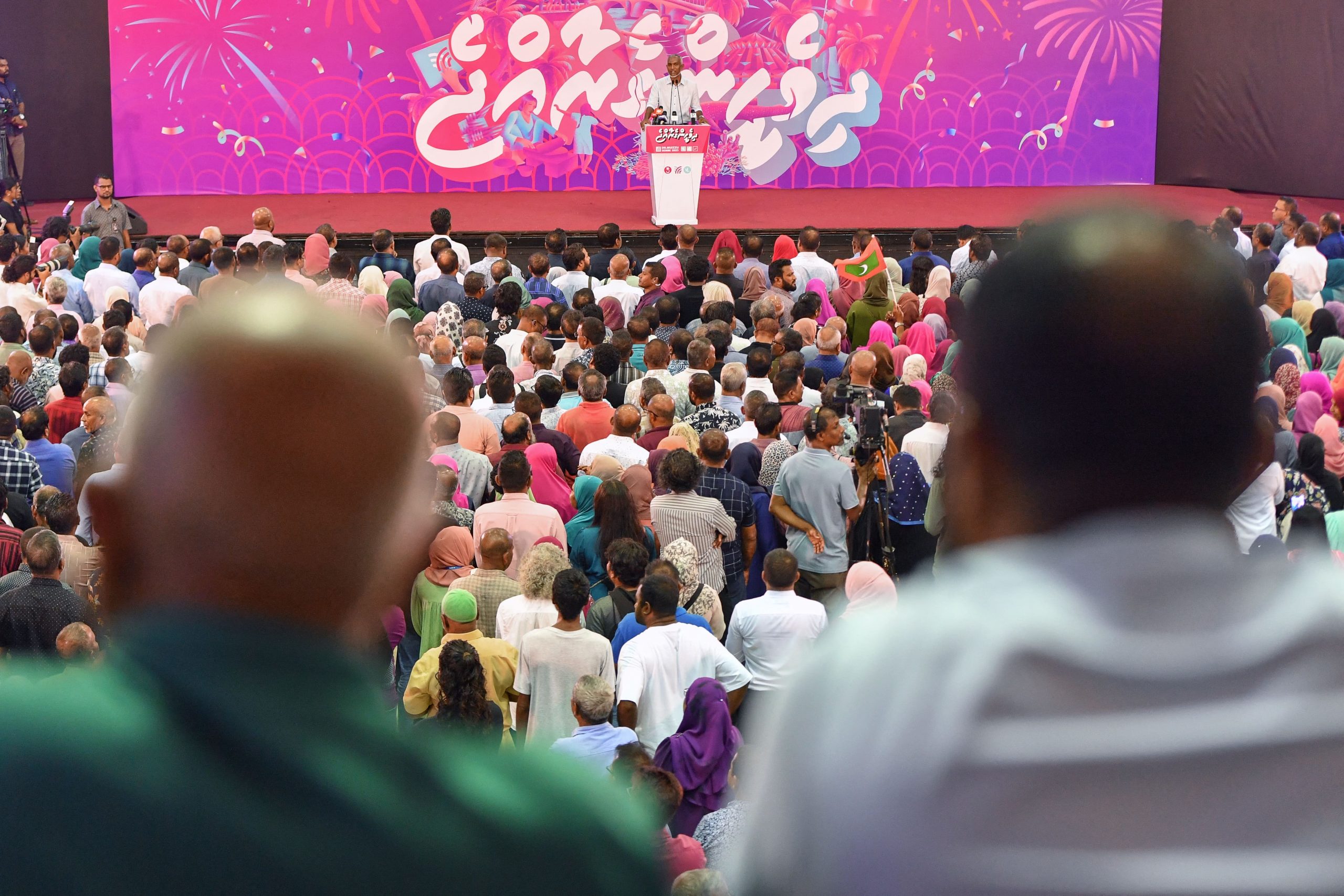
Newly elected Maldivian president Mohamed Muizzu speaks during his inauguration ceremony in Malé on November 17, 2023. Muizzu gained power following a hotly contested election between himself and his predecessor, Mohammed Solih, with the extent of his perceived pro-China stance to be seen through his coming term. Credit: Ishara S. Kodikara / AFP
Silencing and self-censorship
Besides external control and intimidation, self-censorship was practiced across the region. In Bhutan, a survey by the Bhutan Media Foundation found that an astounding 84 per cent of journalists practice self-censorship. Interestingly, male journalists are one and a half times more likely to practice self-censorship compared to their female counterparts. A “small society syndrome,” – a well-knit society where everybody knows everyone else – and the fear of backlash are the two major reasons behind the practice.
In India, fear of reprisal has prompted many media houses to carefully skirt news that is likely to annoy the government and corporate media owners. This has resulted in a dumbing down of critique and avoidance of stories that could rock the boat. Mainstream media in India is rarely carrying out investigative journalism or reporting stories that hold the government to account. Instead, it is the independent digital portals that dare to do journalism in the public interest.
Censorship has always been a convenient tool in the hands of governments. In 2023, soon after the new government in Maldives was sworn in, three anti-government websites with allegedly incendiary content were blocked, amidst loud opposition. The MJA and the Editor Guild’s stressed that the existing legal framework does not allow unilateral action by the government, which was advised to seek remedies through the self-regulatory mechanism of the Maldives Media Council (MMC).
In Pakistan, unsubstantiated complaints of alleged blasphemy online, often puts citizens and sometimes journalists in serious trouble. Journalists practice a significant degree of self-censorship on topics concerning law and religion, to avoid attracting blasphemy allegations. This atmosphere of intimidation has eroded the quality and quantity of independent reporting on sensitive issues.
Mainstream media in India is rarely carrying out investigative journalism or reporting stories that hold the government to account. Instead, it is the independent digital portals that dare to do journalism in the public interest.
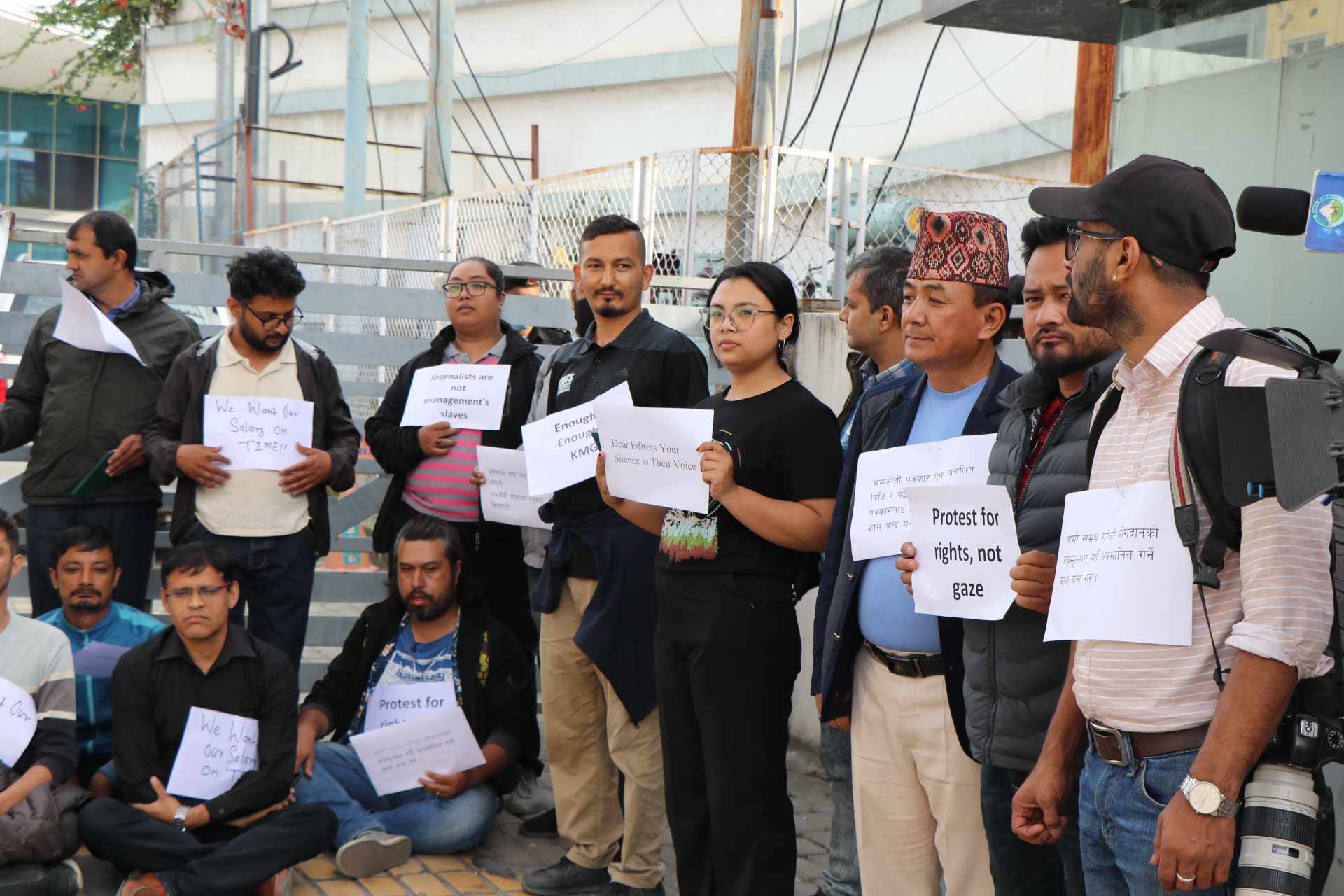
Illegally terminated workers, supporters, and members of the Federation of Nepali Journalists (FNJ) demonstrate outside the offices of the Kantipur Media Group in Kathmandu in October, 2023. After months of protests, the FNJ secured voluntary retirement packages for affected members, with some journalists continuing protest action, in a demonstration of union power amid Nepali media’s economic woes. Credit: FNJ
Credibility and trust in media
“Disinformation that has been ‘scaled up and weaponised’ on social networking platforms presents a major challenge and threat to democracy and media credibility,” said N. Ram, director of The Hindu, one of India’s leading dailies. Speaking at fifth World Media Summit held in Guangzhou, China, in December 2023, he said Artificial Intelligence (AI) and disinformation were “two key areas in which major and potentially disruptive challenges could become opportunities for the media to do well, empower themselves in new ways, and pursue a path of sustained development.” Misinformation, inaccurate information, disinformation, or deliberately misleading and biased information or ‘fake news’ and the entry of AI in newsrooms and on social media, have made the credibility question more complex.
Trust in media was a concern across the region. IFJ and MJA’s ‘Unveiling Public Trust in the Maldivian Media’ report, 2023, found that 87 per cent of respondents held the media accountable for political divisions in the Maldives with television and internet news websites perceived to have the highest levels of sensational or biased coverage, depending on their ownership. Given the lack of fact-checking mechanisms, the high degree of misinformation and disinformation on social media in the run up to the presidential elections in September 2023 went virtually unchecked.
Surprisingly, despite the highly polarised mainstream media in India, trust in the media is high, as per data released by the Reuters Institute’s Trust in News Project (2023). Of the four countries surveyed (the US, UK and Brazil were the others), the Indian public at 65.6 per cent had the highest trust in the media. Significantly, a caste element surfaced, with marginalised ‘Other Backward Classes’ three percentage points lower and the former untouchables the ‘Scheduled Castes’ and indigenous Scheduled Tribes each “more than ten percentage points less trusting”, pointing to the upper-caste and class bias in mainstream media.
In Pakistan, social media was believed to be most responsible for spreading fake news, as per a study by Freedom Network and the Coalition Against Disinformation released in early 2024. Exposure to increased online disinformation poses a threat to Pakistan’s democratic structure and processes, felt the respondents.
In Bangladesh, too, the proliferation of disinformation and false propaganda both for and against the government have been fuelled with and by AI technology. Myths and propaganda about religion or ethnic minorities, incendiary videos and memes built up a climate of impunity that normalised discrimination and violence.
Misinformation and disinformation trends in Sri Lanka were strongly linked to the island’s political economy, along with myths related to ethnic identity and religion – the staples of disinformation campaigns. In the ongoing financial crisis, much of the misinformation was targeted at economic policies including tax controversies such as misrepresentation of common levies drew panic responses. Hoaxes about the economic collapse drove companies to pull out of the island and distorted statistics on food security proliferated.
In Bangladesh, too, the proliferation of disinformation and false propaganda both for and against the government have been fuelled with and by AI technology.
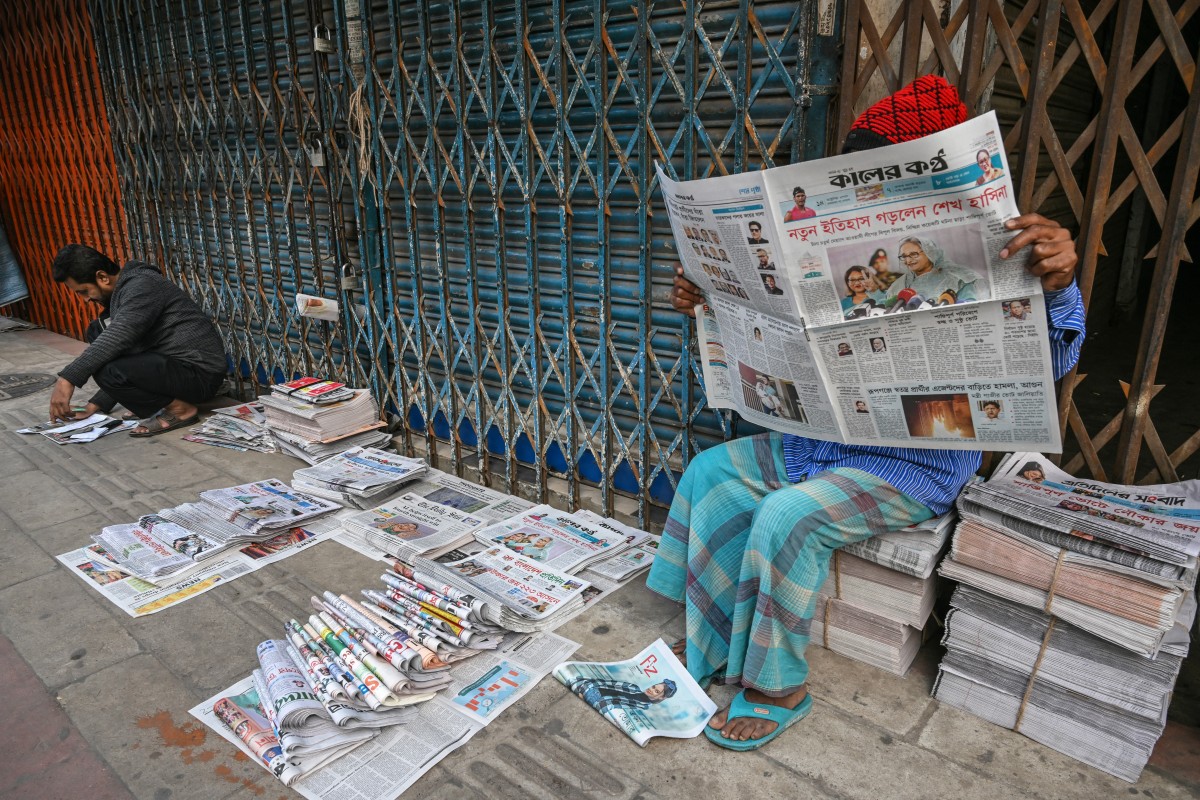
A man reads a newspaper highlighting the election of incumbent Prime Minister Sheikh Hasina and the Awami League party following Bangladesh’s parliamentary elections in Dhaka on January 7, 2024. Hasina’s consolidation of power has seen challenges to democratic rights, civil liberties, and press freedom. Credit: Indranil Mukherjee / AFP
Positive steps
Yet, all was not bleak in the year under review, as journalists, their unions and media support organisations collaborated to improve media rights in extremely challenging circumstances.
In Afghanistan, strengthening the Media Ethics Commission under the Ministry of Information and Culture and establishing coordination committees between journalists and local officials in the provinces was a step towards professionalism. Support from UNESCO’s office in Afghanistan enabled upskilling and training, empowering Afghan journalists and media outlets to produce quality content. Even as the situation in Afghanistan no longer occupies centre stage in world affairs, the challenges faced by the media industry in Afghanistan call for attention from the international community and support to uphold press freedom and independent journalism in the country. The situation of Afghan journalists in exile continues to be of concern, with many of them hanging in a no-visa limbo, with no jobs, while others have been forced to return home.
The vigorous protests against the unjust dismissal of 82 media workers in Nepal by the Kantipur Media Group, the country’s leading private media company, showed that union power can be a strong unifying force. The agreement between the Kantipur Media Group and the Federation of Nepali Journalists (FNJ) in December 2023 led to some relief for the striking workers. However, protest actions continue to ensure implementation of the agreement.
Towards the end of 2023, Maldivian journalists and workers welcomed the enactment of a much-awaited industrial relations bill drafted with technical assistance from the International Labour Organization. Ratified in January 2024, the new law guarantees the right of workers in the Maldives to take industrial action and form trade unions and introduced mechanisms for collective bargaining and dispute resolutions between workers and employers. An accompanying occupational safety and health law seeks to reduce workplace hazards and redress complaints and provide compensation for workplace injury. The MJA called it a “momentous union win” achieved after “a very long-standing strategic execution of plans led by workers and unions”.
In Pakistan, the landmark Sindh Protection of Journalists and Media Professionals Act 2021, an outcome of a collaborative campaign and advocacy, inched toward its practical implementation. The Pakistan Journalists Safety Coalition worked to mobilise the Commission for the Protection of Journalists and Other Media Practitioners (CJMP) notified under the new Act. Further steps were taken in June 2023, when the federal government allocated PKR 1 billion (about USD 5,5 million) to insure journalists against health emergencies. In October 2023, the Khyber Pakhtunkhwa government promised to amend endowment rules and increase financial assistance for the province’s media workers facing financial emergencies or those rendered jobless.
The Pakistani government’s demand in October 2023 that Afghan refugees – including 200 journalists – return to Afghanistan, giving a one-month deadline before forced deportations, saw several solidarity actions. In June 2023, IFJ urged state-sponsored humanitarian assistance for Afghan journalists in Pakistan, while Freedom Network launched the ‘Advocacy Hub for Afghan Journalists’ project in December 2023 to provide financial and legal assistance to over 100 exiled Afghan journalists to help them survive and also continue to report. This is a welcome move particularly for Afghan women journalists in exile in Pakistan, struggling with unemployment, visa issues, out-of-school children, and the threat of imminent deportation.
In December 2023, the Women’s Media Forum Pakistan (WMFP) launched a campaign titled ‘Pakistan’s Media Needs Women’ to advocate gender inclusivity in the media industry and in press clubs. In January 2024, key media stakeholders reiterated their support to WMFP’s campaign, pledging to proactively tackle underlying issues such as inclusivity, equal representation, and fair wages. Alongside, the National Press Club announced a ‘Women Journalists’ Caucus’ and set up a working committee to strategise the initiative aimed at improving competence of women journalists.
A pushback from various stakeholders in Pakistan saw the passing of the Official Secrets (Amendment) Act, 2023, after an uproar in parliament forced the government to withdraw a controversial clause, which would have allowed intelligence agencies to conduct search and seizures – including of journalists – without warrant.
The period in review also saw initiatives to unionise digital journalists with the support of the IFJ. A strategy paper for the establishment of a labour union for digital journalists was used to conduct a series of consultations in Pakistan, awareness campaigns, networking, online engagement, and advocacy with over 50 digital journalists based in Islamabad, Karachi, Lahore and Quetta. The campaign culminated in an application for registration of a trade union for digital journalists with the National Industrial Relations Commission (NIRC).
Journalism at its finest was on display in India, amidst the heat of a landmark general election in April-May 2024, where incumbent Prime Minister Modi bids for his third term. In a significant judgement on February 15, 2024, the Supreme Court of India struck down the validity of electoral bonds, a mode of funding political parties introduced in 2017 by the ruling Bharatiya Janata Party. While the mainstream media lagged, it was feisty independent digital media that sifted through huge amounts of data to make connections between who had donated, how much and to which party. Independent news media websites – Newslaundry, The News Minute and Scroll – with several independent reporters, collaborated to investigate and break stories that revealed a sordid corporate-political combination of patronage and plain extortion. “Project Electoral Bond” as this collaborative exercise was termed, demonstrates that public interest investigative journalism is thriving, despite an atmosphere hostile to independent media.
